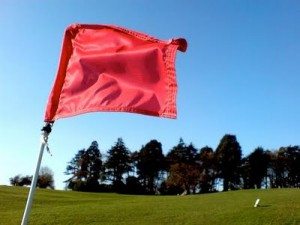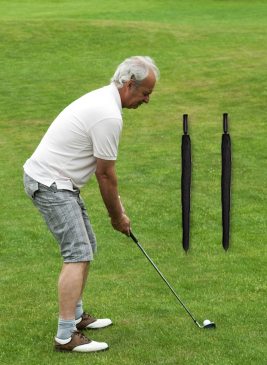Consistent Golf Gazette – 11th March 2012
This year is shaping up to be a great year as far as the pro’s are concerned. You have Phil showing some good form. Tiger’s showing some good form. And Rory is the new number 1 golfer in the world.
The Majors should be very exciting this year, but what about your golf game…
Is this going to be your best golf year ever?
If you suffer with a slice problem then that will undoubtedly be holding you back. You’ll be hitting the ball shorter than you should. You will not look forward to holes with trouble on the right hand side (left if you’re a left hander) and golf won’t be as enjoyable as it should be. Not to mention how your playing partners look at you when you slice it…again and again!
So on Wednesday I’m going to be sending you an email that will help you to permanently fix your slice once and for all. Look out for that. It will make a massive difference to your golf game game this year!
In the mean time read this issue of The Consistent Golf Gazette as I’ve got some great advice that will help you to improve your golf game now…
[divider_bar]Insert Your Text Here[/divider_bar] [headline_arial_large_centered color=”#990000″]Drill To Hit The Ball Straighter[/headline_arial_large_centered]The shortest distance between two objects is via a direct line. So if you’re starting the ball way too far to the left or way too far to the right of where you want your ball to end up, then that’s going to cost you distance.
To hit the ball longer, more consistently you need to work on starting the ball straight where you want.
Years ago a golf magazine had an article with Ken Green, and it showed him hitting golf balls out of his living room through the ranch-slider doors that were open about a foot or so and the ball was flying out onto the golf course that was next to his house.
Crazy stuff!
Now although that may seem a bit crazy it’s actually a great way to work on improving your swing path so you get the ball starting consistently on the line you want it to start.
To do this place some objects in front of where you’re hitting balls so that your ball has to go through them to travel directly towards your target.
A couple of closed golf umbrellas, with the top points pushed into the ground works well for this.
Once they are standing up on their own they essentially form a gateway for your ball to travel through to ensure your ball is starting off on the correct path.
If you hit either umbrella then you know your swing path was either too far left or right, and you’ll know how to correct this by seeing which umbrella you hit.
Here is a picture of a golfer setting up to a ball and I have photoshopped a couple of umbrellas on the image to show you what I mean.
Now when you’re working on your club path you should do so with small swings first. Start off with chip shots trying to hit them through the gate you’ve setup. Then move up to half swings, then three quarter swings and finally, once you’ve mastered all the shorter swings, then full swings with a driver.
Also, you can move the gate closer together so the gap your ball has to fly through is smaller, thus making it harder when you start to get really good at this.
Also, you’ll have to experiment with the distance you position your ball from the ‘gate’. If you really get into doing this you can record how close you’ve got the gap your ball has to fly through and then try to get it closer and closer together.
Make it a competition and try and beat your best.
When doing this you might want to use softer than normal golf balls rather than real golf balls, because if a ball ricochets off your gate and comes back to hit you it might hurt!
[divider_bar]Insert Your Text Here[/divider_bar]Question
When it’s windy I’m not sure what to do. Can you give me some advice on how to play shots when the wind is blowing from different directions?
Answer
The very first thing you must do when it’s windy is to figure out before each shot where the wind is coming from and how strong it is etc.
To do this you must pick up some grass and throw it up to see which way the wind is blowing it from where you are, and how strong it is.
 Then you need to look at trying to assess how strong the wind is, and what direction it’s coming from where your ball is going to be landing.
Then you need to look at trying to assess how strong the wind is, and what direction it’s coming from where your ball is going to be landing.
To do this, have a look at the trees around where your ball is going, to see the direction of the wind there. Wind can be swirling, especially around a tree lined golf course, so don’t expect the wind to be going the same way 250 yards away from where you are.
Have a look at the trees, the flag or anything else that will give you some indication as to the wind direction and speed. And that “anything else” can also be your ears. Listen to the wind to gauge how strong it is. Don’t limit your senses to just sight when playing on a windy day.
So assessing the situation is the most important thing. Once you’ve figured out the wind direction and speed then follow these suggestions.
With the Wind
When you’re faced with a downwind shot you need to get the ball up as soon as possible to take advantage of it. And if you don’t launch your driver high then use a 3 or 5 wood off the tee instead. Let the loft of your club get your ball up in the air, but by all means tee the ball higher.
Another thing you have to be aware of when hitting shots downwind is that the wind will reduce any sidespin you put on the ball. So if you normally hit the ball with quite a bit of hook or slice spin then this will be reduced. So don’t allow for so much curve on the ball.
Into the Wind
A lot of times when amateurs are faced with a shot into the wind they swing harder. But that’s the worst thing you can do because more backspin is put on the ball and it makes the ball balloon up and go nowhere. Instead, when you play into the wind you should take one, two or even three clubs more than usual and swing normally or even slower than normal.
When you do this you should grip down on the grip so your swing will be automatically shorter. Because the shorter your swing the lower the ball will go (generally). Plus to help you keep the ball lower you should play the ball further back in your stance. You should also widen your stance to give you a more stable base from which to hit your shots.
Side Winds
When you’re faced with a side wind shot you have a couple of options. The first is that you can play your natural ball flight (i.e. a fade or draw) and you’ll be either fighting the wind or riding with it. Or if you can control your ball flight you can choose to either go with the wind or fight it.
There’s no right or wrong option here so you have to experiment and find which approach works best for you. Just be aware that if you’re going to go with the wind the ball is going to go further than if you fight the wind. So you’ll need to choose your club appropriately with the choice you’re making.
Now here’s my last piece of advice when you’re playing on a windy day.
The average score on a windy day is going to be a lot higher than a non-windy day. I’ve seen reports for the PGA Tour where the average score raises by 3 – 7 shots over non-windy days. So when you’re playing on a very windy day expect that on average golfers scores are going to be higher than normal.
It doesn’t mean your score is going to be but if you are scoring worse than normal don’t feel bad about it. Just keep having a positive attitude and do your best following the instructions I’ve given you.
[divider_bar]Insert Your Text Here[/divider_bar]OK, that’s the end of this issue of the Consistent Golf Gazette. Remember to look out for my email in the middle of next week if you have a slice problem and really want to fix it for good…this time!
For Consistent Golf,
Jeff Richmond
Director Of Instruction
The Consistent Golf School
http://www.TheConsistentGolfSchool.com
1 Comments
Leave a Comment




I am recovering from an operation but I hope to put your comments into practice soon.i